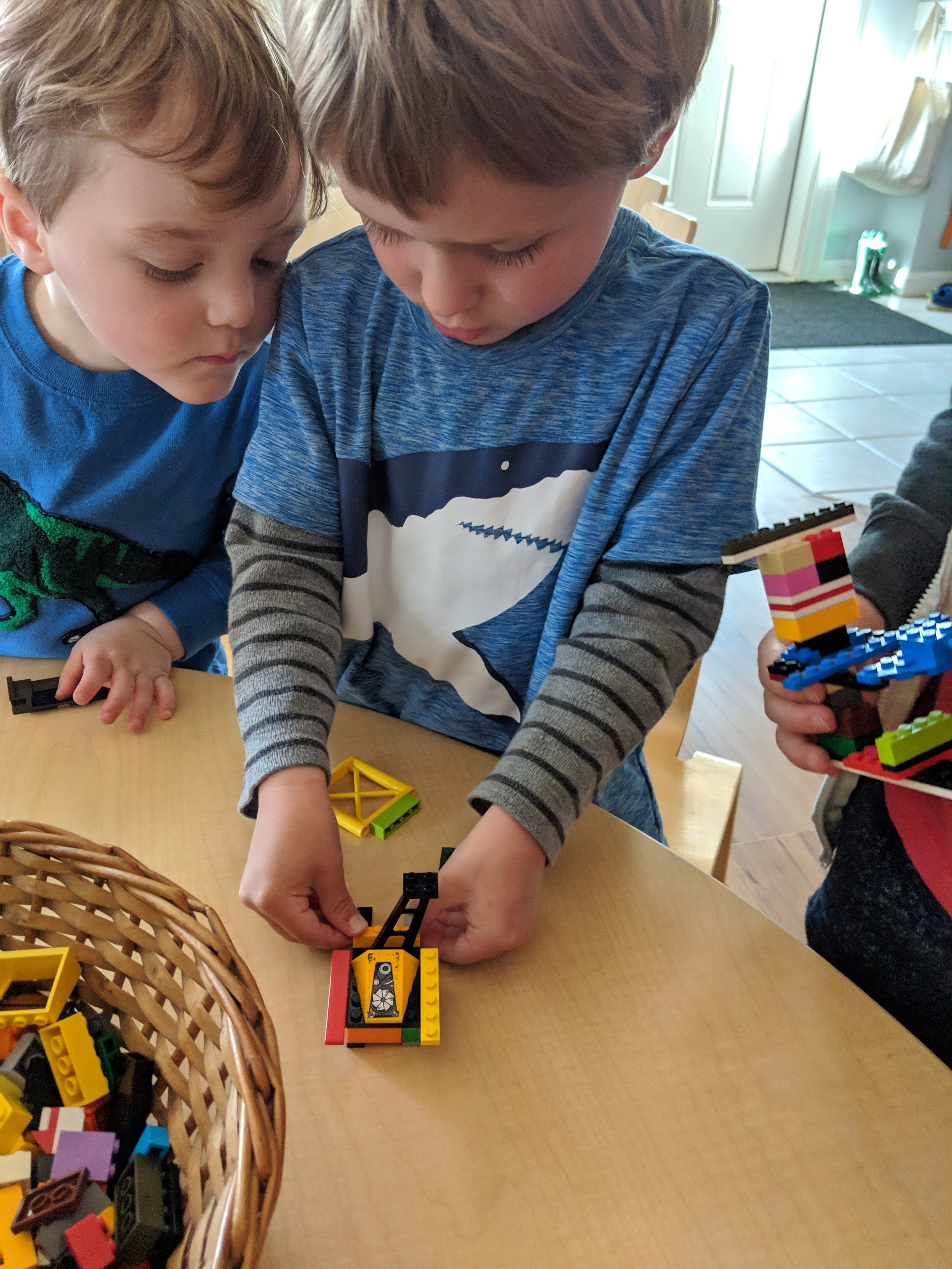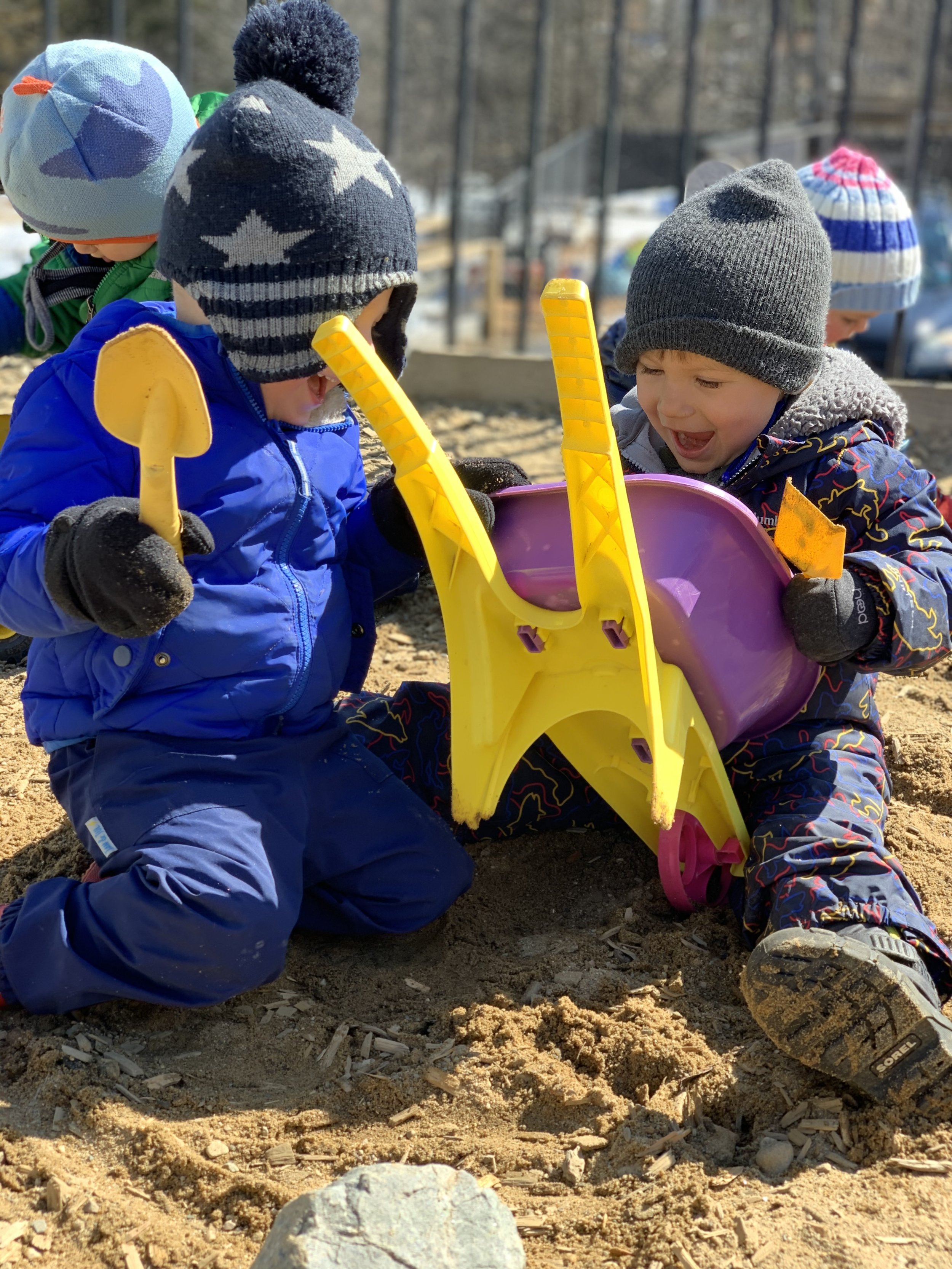SUPPORTING EXPONENTIAL GROWTH IN EARLY CHILDHOOD - PART FOUR: AGE 3
A PROGRESSIVE AGE SERIES WITH A SPRINKLE OF HARMONY MAGIC!
Oh, the beautiful age of 3! It’s a time of magic—when a child’s awareness is opening up to the wonders of the world in ever-deepening ways… Just as we explored the developmental loves and challenges of 12-18-month-olds, 18-24-month-olds, and 2-year-olds, our focus today is on 3-year-olds.
Harmony’s grounds have been teeming with the joys of 3-year-olds for years—it’s a developmental age we both love and understand inside and out. Before we dive into what gets their juices flowing, we want to share what we adore most about this age.
Life is always interesting in the presence of 3-year-olds. Their innate combination of wonder, curiosity, abundant energy, growing self-confidence, and independence spark nonstop fun and adventure. They learn by doing, and the learning never stops. They are interested and intrigued with everything, and anything! As their vocabulary and language development evolve into basic sentences, their quizzical expressions inevitably morph into the adorably relentless: "Why?" and "What happened?"
They're growing in every way; physically, cognitively, emotionally, and socially; learning, developing, and practicing new skills.
Friendships are forming; sharing and taking turns are becoming easier; they are keenly observant, tender-hearted, and caring. They're becoming little individuals with distinct preferences, opinions, and a wide range of emotions.
While new freedom is delightfully exhilarating for them, they still need your loving attention, support, and presence, so continue to engage, encourage, and enjoy your little emerging star!
3-YEAR-OLD LOVES
Rest and Routine
Rest and routine remain critical ingredients to your happy, healthy 3-year-old. Remember that children biologically need a daily nap until at least age 3, and many benefit from midday rest well beyond this time—it all depends on the individual child. Little ones still napping will need that siesta around 6 hours (give or take) after rising for the day, and may snooze for 1-2 hours. Other 3-year-olds will show signs of readiness to drop their nap at some point this year—one cue that it’s time to consider letting that transition happen is when their naps are regularly keeping your little one (or the whole family) up until ungodly hours at night. When you begin to make that transition, the key is to make sure bedtime is early enough for your cutie to continue getting the same cumulative hours of sleep in a 24-hour period.
For a much more in-depth dive into incredible, physiology-based sleep tips and solutions for your littles, we highly recommend checking out the wonder-resource that is Baby Sleep Science. Not only do we concur with their assertion that kids need a nap- or rest-time up to age 3 and beyond, we have personally seen the benefit of continuing a midday quiet time even through the tween years (school-schedules-permitting)! It’s amazing how recharging a daily slice of alone time can be.
Continue to think of naptime (or quiet time) and night sleep as your day’s anchor points, and continue to layer the rest of your daily routine around them. Breakfast right after waking, lunch just before naptime, dinner just before nightly bath, wind-down time, bedtime rituals—and of course, woven throughout your day, our magic formula of independent play, connection, and confident leadership. Children in this age group continue to look forward to and thrive on the predictability of routine. With a healthy, established routine grounding your child’s days and nights, we can add in the variety and excitement adults often need: half-day excursions, full-day excursions when your child transitions out of naps, and even extended family trips. Revolving our days around those daily anchor points and maintaining our familiar routine while in new settings sets the whole family up for success.
Process-Driven Learning
Given the opportunity to freely explore their environment and the materials within, your 3-year-old will unlock his inherent creative, scientific, and learning processes. These inquisitive learners enthusiastically examine their surroundings, immersing themselves in complete sensory experiences. Close observers, they notice and are impressed by the tiniest details of the world.
Leaves, sticks, and acorns become tiny, valuable treasures or building blocks. Rocks instantly need to be climbed. Sand is irresistible to dig, scoop, or manipulate. An open space to race around becomes a make-believe game of human racecars or an evolving exploration of turf and surfaces. Rain puddles and mud jumped into with gusto aren’t just about eliciting broad smiles and giggles of delight—they are explorations of physics as water and mud droplets rise and fall at different rates, and murky ripples encircle little ankles and disappear. (Read more on this topic in our Nurturing Your Child’s Inner Scientist blog post.)
As adults, our instinct is to create a game, or suggest an activity. But often, the mere presentation of an environment or materials will trigger your child’s inner artist/scientist/observer, and he or she will wordlessly dive into a process of exploration and deep learning.
Taking a walk together, riding in the car, doing errands, visiting people and places, and even household activities present inherent, process-driven learning opportunities. Try to stay silent as she observes a tiny ladybug basking on a windowsill or listens to a passing firetruck siren. Return her gaze of awe and wonder, waiting to let her spark conversation led by her questions. All of this is about the process of the activity, and the organic learning that takes place when we remove all expectations from the goal or final desired outcome.
Fine-Motor Work
Old pros at the basics of fine-motor work by now, 3-year-olds are nonetheless primed and eager to continue honing those micro-musculoskeletal skills, aided by their capacity to sustain interest longer. There are endless options to help them flex and build these abilities—while simultaneously offering additional benefits.
Blocks are a powerhouse of benefits, strengthening hand-eye coordination, problem-solving and reasoning skills, math abilities (shape recognition, numbers, measurement, sorting, and estimating), and science (balance, gravity, cause, and effect). Playdough provides fine-motor practice and artistic license as it's rolled, poked, shaped, and small decorations are added. Crayons, markers, chalk, and paints work slightly different fine-motor muscles while inspiring creative expression. Puzzles develop focus, determination, and problem-solving skills. Sensory bins filled with your choice of sand, pasta, dried beans, feathers, or water—and paired with investigative items like scoops, containers, or spoons—result in the delight and engagement of little hands as fine-motor and cognitive skill-building takes off.
Imagination
At age 3, little imaginations soar, and anything seems possible to your young learner. Imagined scenarios help this age group make sense of feelings and experiences. Dress-up and dramatic play allow role-playing, self-awareness, and social-emotional development. For full benefits, keep it unstructured, open-ended, and process-driven, and you might even gain a few minutes to yourself…especially when there are little friends involved…Friends/Cooperative Play
The parallel play of age 2 now naturally progresses into associative, or interactive, play with other children. Whether with siblings or new faces at the playground, chances are, you’ll be watching little connections and imaginative game play sprout. Now is a good time to begin conversations about social cues, personal space, body movement, facial expressions, and the feelings of others.
Reading
By now, your child should be able to identify that the spoken word tree, a picture of a tree, and the written letters in tree all mean the same thing—this is the foundation of literacy, and it’s why introducing reading to the youngest children is so important. Keep up your bedtime and naptime reading and consider adding other story times too.
Let your child choose a book, point to pictures, and help you turn the pages. Make up stories together, rhyme, sing, and laugh! You're bonding, creating memories, and providing a foundation for early literacy skills and a growing enjoyment and value of books. To inspire independent reading, be sure to have plenty of easily accessible picture books for them to find and page through on their own.
The more we expose our children to age-appropriate books and reading, the more deeply we root a lifelong love of reading, planting some of the earliest seeds for educational success.Independence
At age 3, your child is increasingly self-aware, and ever-more capable of executing basic tasks on her own. Continue supporting your child through the smallest facilitating step. Observe your child, offering only the slightest aid as needed to complete the task successfully. Provide opportunities for your budding big kid to shine, through getting dressed, basic self-care, and helping with simple tasks around the house. You’ll know you’re all on the right track whenever you hear that joyous little voice proclaim, “I did it!”
3-YEAR-OLD CHALLENGES
Separation
On the flip side of this new sense of independence is the natural and age-appropriate struggle to separate from mom, dad, and other caregivers. New environments and transitions like preschool drop-off may cause temporary uncertainty and tears, but with your quick, confident, and reassuring goodbye, your child will get through, and will soon be fully trusting your loving “See you soon!” For children particularly challenged by this transition, try tucking a cherished lovey inside the backpack. Before you know it, you’ll be struggling with the bittersweet success of your little one’s confident separation at morning drop-off.Boundaries
Increased independence also comes hand-in-hand with more boundary testing. Our job is to continue to resist the urge to react loudly or dramatically or engage in a lengthy explanation—too much attention is sure to create a fun new pattern for your little one. Calm, predictable, and clear boundaries continue to create an important foundation for the months and years ahead—and will likely make your future life easier.
When inevitable moments of non-cooperation arise, get to your child’s eye level, gently yet firmly hold his hands at his midline (this helps to center his body) and with a firm tone, state: “It is time to put your shoes on." Don’t ask—let it be known that this is the time. If your direction continues to be disregarded, say: "You may put your shoes on now, or I will do it for you." Be sure to follow through. Avoid power struggles with consistent, clear, understandable expectations. For more on how to set boundaries for a defiant little one, visit this Confident Leadership section of a recent post.
Sharing
Preschoolers at this age still can’t quite grasp sharing, so taking turns is key. When children play for extended periods with simple materials, they lay groundwork for concentration and attention span. Therefore, if another child expresses interest in what your child is playing with, let your child fulfill his curiosity, and say, “You may have a turn when James is done.” Redirecting the other child toward another activity may be necessary to keep the peace, but the more you can preserve the focus and attention your little one is cultivating, the more you are strengthening those muscles for future use.
On the flip side, if your 3-year-old is the one who wants to interrupt another child’s focused activity, by redirecting her to another activity and communicating that her turn will come when her friend is done, you are demonstrating and teaching the foundation of future sharing.
Every day will hold different joys and different challenges in this extraordinary season of parenting. A 3-year-old inspires us to see with new eyes, feel with greater depth, live more gratefully and spontaneously, and to take nothing, and no one for granted. Enjoy!
We’d love to see any Harmony-inspired moments you capture along your child’s early years journey. Tag us (@HarmonyNLC) on Facebook and Instagram, and use the hashtags #HarmonyNaturalLearningCenter #TheHarmonyApproach #HarmonyNLC
______________________________
Interested in introducing more of The Harmony Approach to your preschooler at home? Check out Harmony at Home today (FREE activities available).















